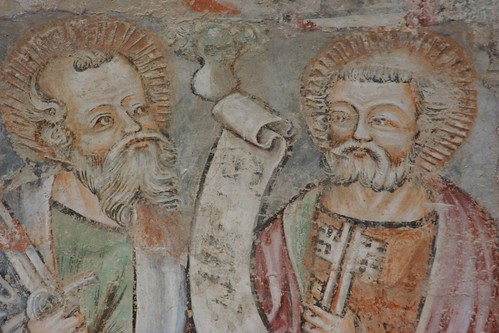I am currently writing a conference paper on Flóris Rómer, one of the
founding fathers of Hungarian art history. Flóris Rómer was born 200 years ago, in 1815, and filled numerous important positions during his illustrious career. He became active in the field of archaeology and art history in the 1860, and published the first survey of medieval wall painting in Hungary in 1874. The book, which is in the focus of my study, is a beautifully illustrated, monumental work, published by the Archaeological Committee of the Hungarian Academy of Sciences.
 |
Self portrait of Johannes Aquila at Velemér
copy by Storno, published by Rómer |
In the book, Rómer discusses over 100 medieval monuments with wall paintings, but the main focus is the work of Johannes Aquila, which Rómer effectively discovered in 1863. At that time, he was called by Imre Gozón to examine an abandonded medieval church in western Hungary, in the village of Velemér. The church had no roof or vaulting, but its walls were covered by a wonderful series of wall paintings. Surprisingly, Rómer also found a self-portrait of the painter as well, who called himself Johannes Aquila. The date of the frescoes was also recorded in an inscription: 1378. Rómer also found the frescoes of Johannes Aquila in the nearby church of Turniscsa (Toronyhely, Bántornya, now Turnišče in Slovenia): here he identified the legend of St. Ladislas in the frescoes located in the attic space, above the Baroque vault covering the nave of the church. Another fresco cycle of Johannes Aquila - again with his selfp-portrait, and dating from 1392 - was found at Mártonhely (Martyáncz, now Martjanci in Slovenia). Rómer also attributed the frescoes in the rotunda of Nagytótlak (Selo, Slovenia) to Johannes Aquila.
At the instigation of Rómer, Ferenc Storno made a set of color copies of the wall paintings, which were published in his 1874 monograph, and are still indispensible tools of research. Quite coincidentally, a series of these copies are currently exhibited at
Műcsarnok (Kunsthalle Budapest), which is normally a place of contemporary exhibitions. The Johannes Aquila exhibition is part of an interesting mix of exhibitions, called the
Slovenian connection, which are accompanying an exhibition of contemporary Slovenian painting. Whatever the reason, the Műcsarnok displays not only Storno's original notebook and sketches, but also the much more detailed large-scale copies executed by István Gróh in 1903 and 1912. These include watercolour copies, as well life-size replicas of the St. Ladislas cycle at Bántornya. In addition, the exhibition also includes a large-scale model of the interior of the church at Velemér, imagined and reconstructed at the stage when Johannes Aquila began his activities there, with the painting of the Adoration of the Magi. The curator of the exhibition is Terézia Kerny, who published a
book on Johannes Aquila a few years ago (the current show is accompanied by a brief - but bilingual - booklet about the painter).
 |
| Copy of the frescoes at Velemér from the sketchbook of Ferenc Storno, 1863, via Rómer 2015 |
Wandgemälde des XIII. und XIV. Jahrhunderts in der Eisenburger Gespanschaft" (pp. 201-215).
 |
| Copy by Storno of the frescoes at Mártonhely - page from Rómer's book |
"Johannes Aquila .... by his hands..." - The Slovenian Connection, on view at
Műcsarnok-Kunsthalle Budapest until September 29, 2015.
Some of my photos of the paintings of Johannes Aquila - along with other photos of medieval wall paintings in Slovenia - are available in my
album on Flickr.







